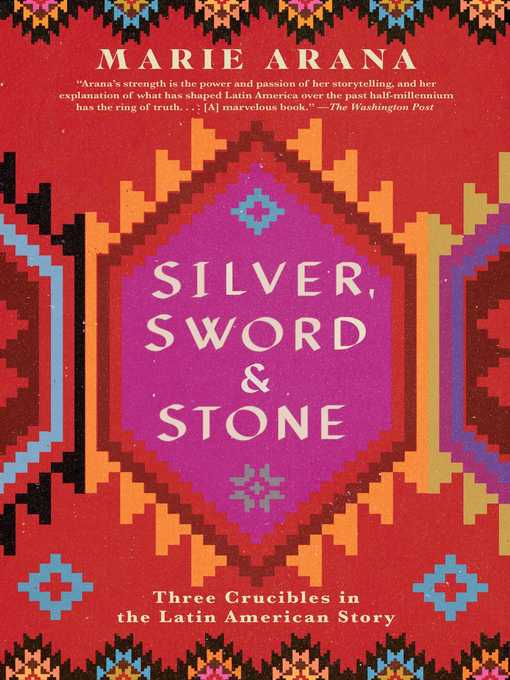
Silver, Sword, and Stone
Three Crucibles in the Latin American Story
کتاب های مرتبط
- اطلاعات
- نقد و بررسی
- دیدگاه کاربران
نقد و بررسی

March 1, 2019
National Book Award finalist Arana captures the exploitation, violence, and religious fervor that have defined Latin America by profiling three individuals: Leonor Gonzales, like her forbears compelled to work the mines high in the Peruvian Andes; Carlos Buergos, a veteran of the Angolan war who was among the criminals expelled by Cuba in the 1980s; and Jesuit priest Xavier Albó, who traveled from Barcelona to preach among indigenous peoples, as priests have done since the Spanish Conquest.
Copyright 2019 Library Journal, LLC Used with permission.

June 15, 2019
The Peruvian-born author delves into the tripartite crux of Latin American exploitation by the Western powers. Arana (Bolívar: American Liberator, 2013, etc.) skillfully moves between the past and the present in this story about age-old "metal hunger" and authoritarian strongmen. She begins with a poignant contemporary description of Leonor Gonzáles, a woman miner aged beyond her 47 years, a mother and grandmother living and toiling in the "highest human habitation in the world," La Rinconada, in the Peruvian Andes, hunting for the illegal gold that Western mining companies need to keep economies buoyant. This lust for precious metals is a story that has haunted and corrupted this continent for centuries. Arana traces the histories of the first civilizations in Bolivia, Peru, and Mexico that used the metals for religious worship, long before the rumors of their "value" became known to European powers. The early Inca, Maya, and Aztec rulers were enlightened, yet they had begun to fight among themselves; Arana notes that it wasn't until the 15th century that metal was used for killing--previously, it was the obsidian bludgeon. Not until the conquistadors landed on Latin American shores did the native peoples learn the murderous power of these shiny metals. The first meeting between Hernán Cortés and Montezuma, in 1519, marked the first fateful connection, and everything changed swiftly, according to the ancient prophesy--slaughter, plague, destruction. The numbers are telling: By 1618, Mexico's Indigenous population of about 25 million people had plunged to less than 2 million. Added to this has been the depressingly enduring legacy of autocratic rulers, and Arana pointedly explores the ways that generational trauma has been passed down to this day in a heritable form of PTSD and constant worry. "A sudden revolt, a foreign intervention, a pigheaded despot, a violent earthquake might bring down the house of cards," she writes, closing her impressively concise yet comprehensive history. A profoundly moving and relevant work that provides new ways of thinking about the "discovery of America."
COPYRIGHT(2019) Kirkus Reviews, ALL RIGHTS RESERVED.

Starred review from August 1, 2019
Arana's (Bol�var, 2013) fluency in Latin American history blossoms in this unique and arresting inquiry into three crucibles which have shaped Latin American life for centuries: lust for precious metals, proclivity for violence, and fervor for religion. She also illuminates the region's cultural splendor and entrenched racism as she combines scholarship with reportage. Arana vividly recounts how the Incas' strictly supervised ceremonial use of silver and gold crumbled under the precious-metals mania of the eleventh Lord Inca, Huayna Capac, who then fell to the gold-mad, greedy, and genocidal conquistadors. In the present, she portrays Leonor Gonz�les, who continues the ancient backbreaking practice of scavenging for gold in the Peruvian Andes even as multinational, environmentally disastrous mining operations are underway. Arana traces the legacy of brutality, which began long before Spain's conquest and grew even more horrific in our time via barbaric wars, vicious dictators, and the savage illegal narcotics trade, forcing many Latin Americans to seek safety in the U.S., a theme encapsulated in the life of Cuban exile Carlos Buergos. Stone encompasses the indigenous, earth-rooted faith and the domination of Catholicism, an evolution encapsulated in the experiences of Xavier Alb�, a Spanish Jesuit in Bolivia. In this masterwork of exploration, connection, and analysis, Arana offers a fresh, gripping, and redefining perspective on a vital and magnificent region betrayed by toxic greed and vicious tyranny.(Reprinted with permission of Booklist, copyright 2019, American Library Association.)

























دیدگاه کاربران